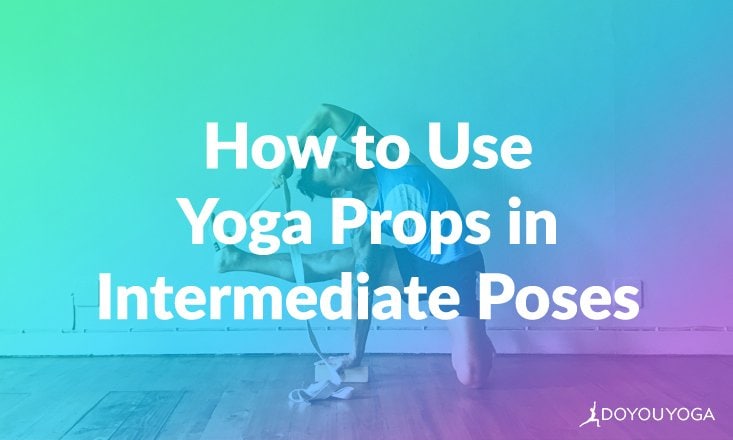Practices like Restorative yoga and Rope wall yoga are completely centered on the use of props. From straps to blocks to bolsters, and even walls, props can be an excellent way to create more space and stability in your yoga practice. Props are great teaching tools that can also help students understand and access postures they might not otherwise be able to without them.
The following are 3 intermediate yoga postures that typically require immense flexibility and/or strength, but with the use of props, can make the posture accessible for any yogi (willing to put in the work).
Natarajasana or King Dancer’s Pose
King Dancer’s pose is a deep backbend that calls upon a lot of space in the hip flexors, quadriceps, chest, and shoulders. It equally requires strength of the standing leg to root down for balance and stability. For many yogis, it can feel impossible for the arm to extend over the head and reach for the back foot no matter how high they lift the thigh.
The use of a strap can help to bridge the gap between hand and foot, helping students to work on opening the front body while building on shoulder and core strength to hold the strap and maintain balance.
- Stand near a wall for balance.
- Wrap the strap around the ankle or arch of your foot.
- Bend your leg and pull the foot closer to you, taking the slack of the strap over your shoulder.
- Hold the slack of the strap in one hand, walking the hand as close towards the lifted foot until the strap is taut.
- Wrap the outer shoulder forward, and extend the elbow up and draw back.
- If you feel steady, you can take the other hand to the strap and apply the previous step to both shoulders.
- Draw the navel in, and lengthen the tailbone back to decompress the lumbar spine.
Visvamitrasana or Visvamitra’s Pose
This epic posture, dedicated to the sage Visvamitra, requires tremendous shoulder strength and flexibility, leg strength and flexibility, and core strength and balance. It is easily one of the most complex postures to practice—it’s an arm balance, twist, hip-opener, and hamstring-lengthener rolled into one.
However, its complexity does not mean that it is impossible to practice. Modifying to Ardha Visvamitrasana, and using a block and a strap, can make this challenging posture accessible to any persevering yogi.
- Facing the front of your yoga mat, come into a low lunge with the right foot forward, and the left leg back and the left knee down.
- Turn the left shin on a 90-degree angle so the left foot ends up slightly off of the yoga mat, perpendicular to the right leg. Tuck the toes under.
- Place the block on the inside of the right foot, and press the right palm firmly down into the block.
- Create a loop with the strap and wrap it around the sole of the right foot, holding the slack end of the strap with your left hand.
- Press the right arm and inner right thigh against one another firmly to activate the strength of the right leg.
- Use your left arm to pull the right leg up and off the floor.
- Internally rotate the left arm turning the elbow upwards to the sky, opening the chest.
- Lengthen your tailbone down.
Lolasana or Pendant Pose
Translated to Pendant pose, Lolasana is an arm balance that can appear to demand the strength of a viking. While it does require a particular amount of arm and core strength, it is one of the more accessible arm balance postures. Using blocks to ‘bring the floor closer to you’ can help you to access your shoulder strength, which might make the difference between lifting your feet or not.
- Start seated in Vajrasana (or Thunderbolt pose) with two blocks on either side of your knees (play around with the height that feels suitable to you).
- Press your palms firmly down into the blocks and round your back like in Cat pose.
- Keep your feet on the floor, you can cross your ankles if it helps, and pull the knees up towards the chest. Hold for 5 to 10 breaths.
- Repeat the above step, and additionally think of pulling the heels towards the buttocks so the strength of the hamstrings helps to lift the feet off of the floor.
- Make sure that you actively press the hands firmly into the blocks to spread the shoulderblades away from the spine, and additionally hug the upper arm bones together for more access to arm strength.
The use of yoga props can change the way you approach intermediate postures. Once you learn how to use yoga props safely and effectively, the postures you once deemed unattainable can become more accessible. Getting creative with your yoga practice can turn anything into a prop; a towel or belt can replace a strap, a bench can be used to lengthen the hamstrings in a Hanumanasana variation, or to open up the thoracic spine in a backbend.
Prop usage and their possibilities are endless and have the ability to transform a yoga practice, specifically in helping to access intermediate and more advanced postures. Have a block and strap handy the next time you step onto your mat and be creative.





